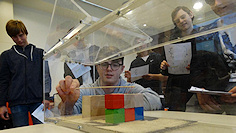|
|
|
Close Help | ||||||||||||||
Přijďte k nám ve dnech 12., 14. a 16. listopadu 2019, ať vidíte, na čem děláme! Více zde.

The remarkable properties of shape memory alloys (SMA) that are utilized in a number of useful applications are due to a phase transformation between austenite and martensite. In many situations, the transformation does not proceed homogenously, but in the form of macroscopic transformation bands, i.e. in a highly localized manner. Since these inhomogeneities influence the mechanical response and reduce the fatigue performance of SMA products, the roots and mechanisms of localization have been investigated by material scientists and engineers for many years [1]. The principal open questions concerned morphology and stability of the macroscopic phase interface in the material. However, deeper analysis and understanding of the phenomenon has been hindered by a lack of detailed microstructural experimental data so far.
A team of scientists from the Institute of Physics and the Institute of Thermomechanics of the Czech Academy of Sciences and the European Synchrotron Radiation Facility [2] has recently contributed to the topic by investigating localization in a NiTi SMA wire loaded in tension. In a unique experiment (see Figure) utilizing the advanced technique of three-dimensional X-ray diffraction (3D-XRD), complete strain and stress states of the polycrystalline grains close to the macroscopic transformation band front have been resolved on a grain-by-grain basis for the first time. Results show substantial heterogeneity of stress between grains – implied by anisotropy of both elastic and transformation properties – and a striking redistribution of macroscopic (homogenized) stress near the interface. Analysis of the experimental data allowed the team to adapt an established constitutive model tailored for NiTi SMA [3] so that non-local, gradient effects could be included. Consequent numerical simulation of the propagating transformation band demonstrated how the internal stress redistributes close to the phase interface within the wire causing the macroscopic localization to occur. The important findings have been published in a recent issue of the prestigious scientific journal Science [4].
For further scientific information please see also the dedicated website and the press report of the Czech Academy of Sciences.
Reference:
1. P. Šittner, Y. Liu, V. Novak, On the origin of Lüders-like deformation of NiTi shape memory alloys, J. Mech. Phys. Solids, 53, 1719–1746 (2005).
2. www.esrf.eu
3. P. Sedlák, M. Frost B. Benešová, P. Šittner, T. Ben Zineb, Thermomechanical model for NiTi-based shape memory alloys including R-phase and material anisotropy under multi-axial loadings, Int. J. Plast. 39, 132–151 (2012).
4. P. Sedmák, J. Pilch, L.Heller, J. Kopeček, J. Wright, P. Sedlák, M. Frost, P. Šittner, Grain-resolved analysis of localized deformation in nickel-titanium wire under tensile load, Science 353, Iss. 6300 (2016), Doi: 10.1126/science.aad6700

The 3D-XRD method enables nondestructive evaluation of grain microstructure of a polycrystal exposed to external stress. In the experiment, a superelastic NiTi wire was stretched until the middle of the transformation plateau and the wire segment containing the martensite band front (B) was probed by a monochromatic beam (A) of high energy X-ray photons at the Materials Science Beamline ID11 at ESRF Grenoble. The grain microstructure (C) was reconstructed from 36650 2D diffraction patterns obtained from the wire during rotating and scanning about its axis with respect to the synchrotron beam (A). A complete description of the martensite band front and the mechanism of its propagation were obtained from the analysis of these results supplemented with FE simulation of the localized tensile deformation (D) using an original SMA constitutive model..